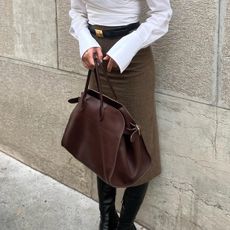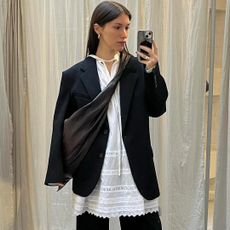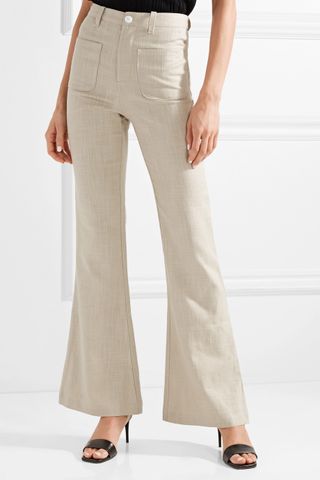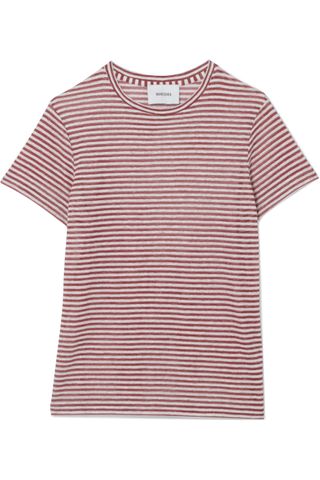Make This One Easy Wardrobe Swap to Help Save Our Oceans

It’s no secret that the fashion industry isn’t particularly eco-friendly. As the world’s second largest polluter after only oil and gas, it’s easy to imagine how fashion emits harmful greenhouse gases in its production and leads to waste piling up in landfills, yet there’s another equally pressing issue at hand when considering the industry as it stands—and it’s one that hits close to home.
If you live in a coastal city, or have even spent a holiday by the beach, you likely have experienced the allure of the ocean. Vast, beautiful, and teeming with at least 750,000 marine species, the ocean covers over 70 percent of our planet—yet despite knowing this, we continue to harm and pollute it at an alarming rate. And fashion is only contributing to the problem.
While most consumers understand that fast fashion is partly to blame for this pollution, what’s less obvious are the effects that have a slow-burn consequence. While it’s easy to see a piece of trash floating in the water, it’s not so easy to see the second-hand impacts of practices such as unsustainable farming.
In fact, we’re willing to bet that you may not have even known that some of your favourite clothes are made with fabric that is doing a hefty amount of damage to our oceans: Cotton. Given its popularity, it would be fair to assume that cotton is relatively easy to farm, however, this is far from true. Despite the fact everything from your favourite T-shirt to your mum jeans (yes, denim is 100 percent cotton) continues to be one of the industry’s leading textiles. In fact, cotton currently contributes “24% of the world’s insecticides, and is extremely water-intensive — yet it’s used in about two-thirds of all clothing“ the founder of the sustainable clothing brand Reformation, Yael Aflalo, notes.
But what exactly is the problem with cotton—and what can we do about it? While production and waste definitely plays a part, “cotton’s environmental impact lies in two areas : Water use and agro-chemicals”, The Huffington Post reports. And while these problems may at first sound minimal, both have a direct effect on the ocean and the marine life within it. While all of this is very depressing (to say the least), don’t let the facts leave you feeling helpless; taking a step in the right direction is as easy as shopping more consciously.
With the negative impacts of cotton in mind, a simple way to reduce your personal impact is by making easy swaps where you can. When shopping, read the labels of the clothes that you’re trying on and aim to opt for more eco-friendly materials. One example— that is also conveniently very on-trend right now—is linen. Buying a linen tee instead of cotton, for example, means that 194 less gallons of water are being used to produce your favourite staple item. By shopping better alternatives and sustainably-made clothing, we all have the opportunity to vote with our dollar and start inciting change in the industry today. And if you’re looking for somewhere to start, never fear. Below we’ve rounded up some of our favourite linen pieces this season to get you considering just how stylish helping our oceans can really be. And while the weather is far from linen-friendly at the moment, styling with a few layers and leather boots will keep you warm and equally fashion-forward.
Shop our favourite linen pieces
See? Caring for the environment can be simple and stylish.
Related: Shop These 8 Sustainable Australian Brands to Help Reclaim Our Future
-
 I Tried On 13 of Reformation's Best Spring Items That I'm Sure Will Sell Out
I Tried On 13 of Reformation's Best Spring Items That I'm Sure Will Sell OutTrust me—they're good.
By Allyson Payer
-
 Anya Taylor-Joy's Posh Reformation Shoes Look Like They Cost Triple the Price
Anya Taylor-Joy's Posh Reformation Shoes Look Like They Cost Triple the PriceWorthy of a London night out.
By Allyson Payer
-
 According to TikTok, Reformation's New Bag Is a Great Alt for The Row's Margaux
According to TikTok, Reformation's New Bag Is a Great Alt for The Row's MargauxThis one won't stay in stock for long.
By Eliza Huber
-
 Reformation Finally Launched Swimwear, and the Collection Is Pure Elegance
Reformation Finally Launched Swimwear, and the Collection Is Pure Elegance*Orders every suit.*
By Eliza Huber
-
 The Ultimate Spring Shopping List: Every Must-Have Buy for a Stylish Season
The Ultimate Spring Shopping List: Every Must-Have Buy for a Stylish SeasonSponsor Content Created With Net-a-Porter
By Raina Mendonça
-
 What to Buy From Reformation If Your Vibe Is Chic Mom and Your Budget Is $250
What to Buy From Reformation If Your Vibe Is Chic Mom and Your Budget Is $250No one does it better.
By Nicole Akhtarzad Eshaghpour
-
 All My Outfits Right Now Are Built Around These 5 Items
All My Outfits Right Now Are Built Around These 5 ItemsI plan to transition these right into spring.
By Caitlin Burnett
-
 My Friend Asked What to Buy From the Net-a-Porter Sale—I Sent These Chic Picks
My Friend Asked What to Buy From the Net-a-Porter Sale—I Sent These Chic PicksThese feel timeless yet on-trend all at once.
By Jennifer Camp Forbes















